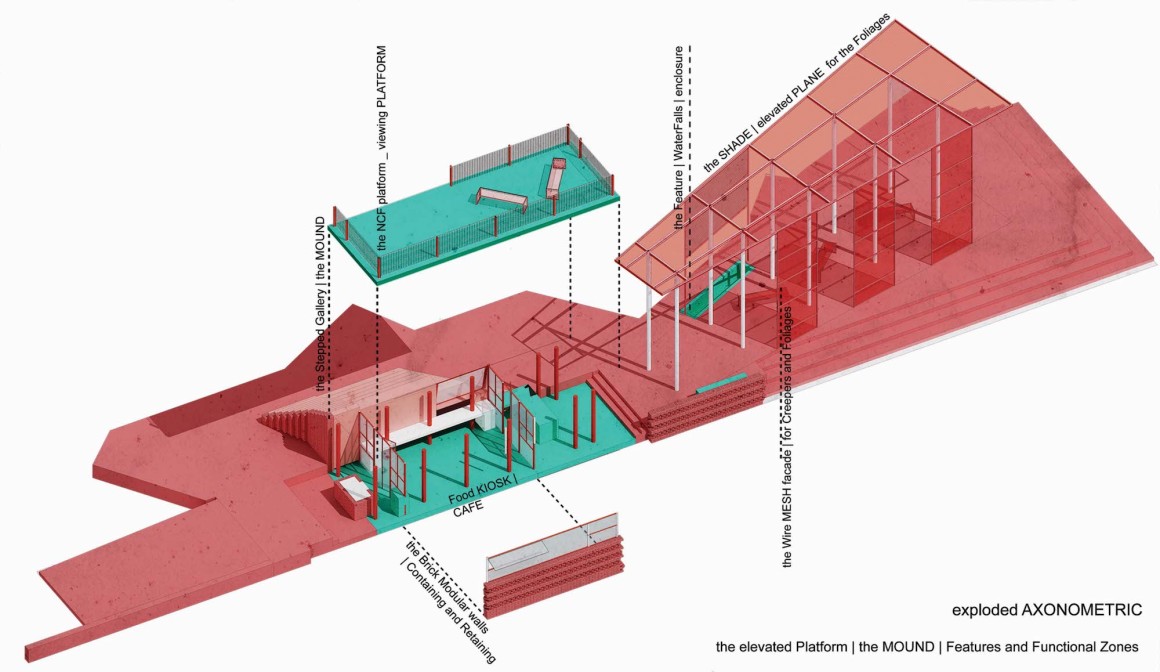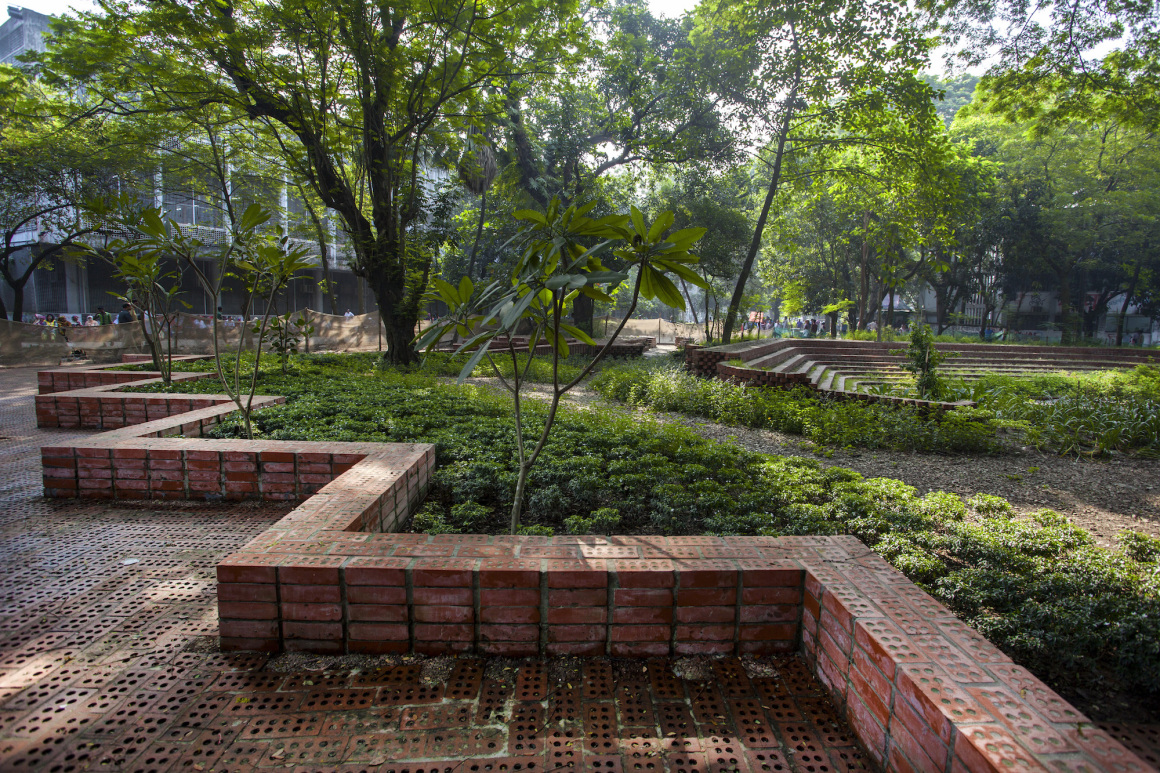本文由 STHANIK Consultants 授权mooool发表,欢迎转发,禁止以mooool编辑版本转载。
Thanks STHANIK Consultants for authorizing the publication of the project on mooool, Text description provided by STHANIK Consultants.
STHANIK:原项目场地虽被清真寺、中央图书馆、学生会大楼、历史悠久的食堂以及新社会科学学院等多个重要地标建筑环绕,却没有起到任何功能性的作用。尽管位于达卡大学的中心地带,多年来一直无人看管,场地本身没有给使用者提供任何使用空间,反而常被用作交通捷径和建筑垃圾倾倒区,周围自然环境受到阳光、土壤条件和人为干预等因素的影响较少,但也是野蛮生长。
STHANIK:Surrounded by significant landmarks like Central Mosque, Central Library, Central Student Union Building, a historic Canteen and also the new building of the Faculty of Social Science, the open space failed to create any significance regarding the usage. Despite of being located at the heart of university of Dhaka, the area remained ‘unattended’ for years. The place itself had nothing to offer to the users, and was being used for shortcuts and dumping zone of construction debris for several years. Natural setting was random but guided by the influences like sunlight, condition of the soil and less human intervention.

▼场地平面 Site Plan

该项目的目标是为年轻人创建一个聚集空间,可举办小型聚会、方便师生默祷和深思的场所。而在这样一个特殊区域创造开放性景观,更是需要集中额外的注意力,于是,半开放的餐饮亭设计便成为了我们维护场地和活跃空间的催化剂。
The objective of the project was to create a meeting place for the young mind, holding small gatherings which may act as a place for contemplation and reflection to the students and faculties. Maintenance of a open landscape in a prominent area like this demands additional attention and the requirement of a semi-open food kiosk emerged as the catalyst to maintain the site as well as making the space lively.
▼设计过程 Plan Diagrams

▼项目总平面 Master Plan

▼项目结构轴测图 Exploded Isometric, Food kiosk and Shade

▼半开放餐饮亭前后场空间 The semi-open food kiosk surroundings


▼半开放长廊 The shade


施工技术:项目中运用了当地传统的“挖掘和堆土”理念,在地面上下3英尺的范围内勾勒地形层,创建出景观地形。而由此形成的土地形态和空间都源自于场地的独特模式,包括现有树木和周围的建筑形式,在美学和项目方面都具有鲜明的特色。
Construction Technology: Based on the very basic idea of ‘Dig and Mound’, traditionally used in our context, topographical layers are created within a range of 3 feet below and above ground to create a landscape terrain. The shapes and spaces in the land formation emerged from the unique site specific pattern of existing trees and the surrounding built forms of distinct characteristics in terms of both aesthetic and program.
▼结构分解轴测图 Exploded Isometric




位于地形层间隙中的半开放咖啡亭,一侧临近围绕水体的下沉式台阶,一侧靠近大树的中间水平处。咖啡亭形似阶梯走廊,面向下沉水体空间,以中央图书馆的立面为背景,与此同时,旁边悬挂的金属桥增强了朝向清真寺、图书馆和社会科学学院节点的方向性。它允许灌木自由生长,阳光穿透其多孔的表面形成光影相互作用。
The semi-open café emerges within the gap created from the changes in topographical layers which starts from the sunken steps surrounding the water body and ends near intermediate level of a large tree. The continuous surface takes the form of a stepped gallery facing the sunken water body with the façade of the central library as the back-drop. Hanging metal bridge enhances the directionality towards the node of the mosque, library and social science faculty. It allows the free flowing growth of the shrubs, interplay of lights and shades through its porous body.



所有这些产生“停留”或“边界”的元素都是从现有的特色树种和树叶中产生或终止的。多孔砖采用软硬组合的方式,将红色氧化物涂层金属装置与绿松石色纯水泥饰面相结合,既融入了“废墟”的精髓,也创造了丰富的“外围形象”。
All of these elements creating ‘pause’ or ‘thresholds’ generates from or terminates towards the existing trees of unique species and foliage. Perforated bricks were used with patterned combination of soft pave to hard pave. Red Oxide coated metal installations combined with turquoise colored neat cement finish infuses an essence of ‘ruins’ and creates a rich ‘peripheral image’.



这种设计方法侧重于创造沉思的场所,让主要由年轻人组成的用户群体可以在校园生活中“短暂停留”。设计干预为用户提供了一个“精心设计”的“邂逅场所”,包括中央图书馆延伸出来的阅读区,从中央清真寺祈祷出来后就能到达的聚会场所,邻近中央学生会的扩展讨论区和历史悠久的食堂。
The design approach focused on creating a place for contemplation where the users, primarily consisting of young age group, can take a ‘momentary pause’ in between their campus life. The design intervention offers a ‘place’ for ‘choreographed encounter’ to the users through creating an extended reading area from the central library, gathering place after prayer at central mosque, extended discussion ground adjacent to Central Student Union and a historic canteen.


为了将“荒芜的场地”转变为能够对用户产生影响的“场所”,设计策略侧重于创建“记忆档案”。下沉的水体作为“逆光”空间,既反映了不断变化的大气现象,也提供了一个静思的空间。
For transforming a ‘non-place’ into a ‘place’ that is able to create an impact to the users, the design strategy focused on creating ‘an archive of memories’. A sunken water-body, the ‘Reverse Oculus’, holds the reflection the ever-changing phenomena of atmosphere and offers a place for contemplation.


种植在水中心的“Hijol树”体现的是勾起村庄池塘回忆的形象,其他精心制作的材料,也共同营造了一种充满怀旧的多感官体验。
The ‘Hijol Tree’ planted at the center of the water embodies an image to recall memories of village pond. Crafted materiality is explored to create a multi-sensory experience infused with nostalgia.

▼剖面轴测效果图 Exploded Isometric


项目名称:达卡大学“Shomaj Biggyan Chattar”:以景观营建场所空间
建筑事务所:STHANIK Consultants
公司网址:https://www.sthanikconsultants.com/
联系邮箱:sthanikconsultants@gmail.com
公司地址:孟加拉国 达卡
主创建筑师:Saiqa Iqbal Meghna, Suvro Sovon Chowdhury
主创建筑师邮箱:meghahmed@yahoo.com
完成:2016年
总建筑面积:20,000平方英尺
项目地点:孟加拉国 达卡
施工:Nazmul Ahsan, Arcadia
照片来源:Iwan Baan(studio@iwan.com), Noufel Sharif Sojol(nssojol4212@gmail.com), Amlin Iqbal Eshita(amlin.i.eshita@outlook.com), Doyeedth Annahaal
Project Name: ‘Shomaj Biggyan Chattar’ at University of Dhaka: Transforming a ‘Non-Place’ through Architecture as Landscape Event
Architecture Firm: STHANIK Consultants
Website: https://www.sthanikconsultants.com/
Contact e-mail: sthanikconsultants@gmail.com
Firm Location: Dhaka, Bangladesh
Lead Architects: Saiqa Iqbal Meghna, Suvro Sovon Chowdhury
Lead Architects e-mail: meghahmed@yahoo.com
Completion Year: 2016
Gross Built Area: 20,000 sq.ft.
Project location: Dhaka, Bangladesh
Construction: Nazmul Ahsan, Arcadia
Photo credit: Iwan Baan(studio@iwan.com), Noufel Sharif Sojol(nssojol4212@gmail.com), Amlin Iqbal Eshita(amlin.i.eshita@outlook.com), Doyeedth Annahaal
更多 Read more about:STHANIK Consultants




0 Comments